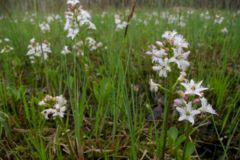 |
The Buck-bean, or Bog-bean, which is common enough in stagnant pools, and on our spongy bogs, is the most serviceable of all known herbal tonics. It may be easily recognized growing in water by its large leaves overtopping the surface, each being composed of three leaflets, and resembling the leaf of a Windsor Broad Bean. The flowers when in bud are of a bright rose color, and when fully blown they have the inner surface of
their petals thickly covered with a white fringe, on which account the plant is known also as "white |
fluff." The name Buckbean is perhaps a corruption of scorbutus, scurvy; this giving it another title, "scurvy bean." And it is termed "goat's bean," perhaps from the French le bouc, "a he-goat." The plant flowers for a month and therefore bears the botanical designation, "Menyanthes" (trifoliata) from meen, "a month," and anthos, "a flower." It belongs to the Gentian tribe, each of which is distinguished
by a tonic and appetizing bitterness of taste. The root of the Bog Bean is the most bitter part, and is therefore selected for medicinal use. It contains a chemical glucoside, "Menyanthin," which consists of glucose and a volatile product, "Menyanthol." For curative purposes druggists supply an infusion of the herb, and a liquid extract in combination with liquorice. These preparations are in moderate doses, strengthening and antiscorbutic;
but when given more largely they are purgative and emetic. Gerard says if the plant "be taken with mead, or honied water, it is of use against a cough"; in which respect it is closely allied to the Sundew (another plant of the bogs) for relieving whooping-cough after the first feverish stage, or any similar hacking, spasmodic cough. A tincture is made (H.) from the whole plant with spirit of wine, and this proves most useful for clearing
obscuration of the sight, when there is a sense, especially in the open-air, of a white vibrating mist before the eyes; and therefore it has been given with marked success in early stages of amaurotic paralysis of the retina. The dose should be three or four drops of the tincture with a tablespoonful of cold water three times in the day for a week at a time.
Herb Simples
The Primitive Simplers presented here show the way of life in other generations, it is not suggested or recommended trying them yourself. |


